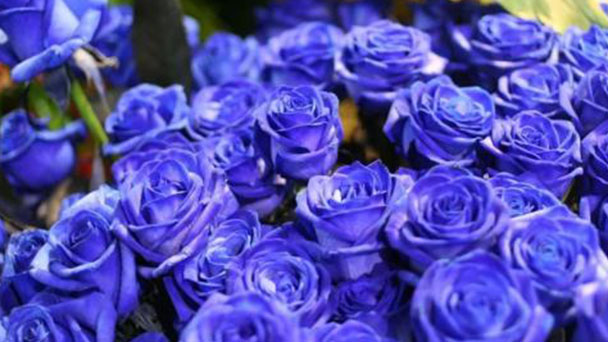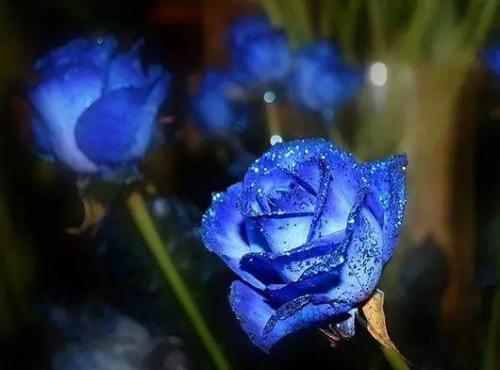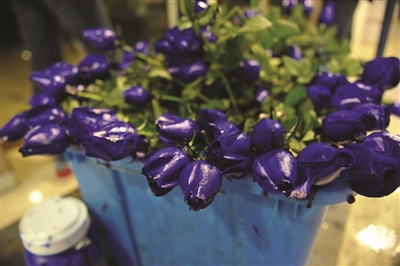Rosa hybrida profile
Written by Maggie
Feb 22 2021

Rosa Hybridda originally from Holland, is a kind of processed flower. Rosa Hybridda is a kind of harmless to the human body dyeing agent and dye aid to adjust the synthesis of coloring agent, such as white rose (or white rose) to the flowering period, began to water flowers with dyes, so that flowers like water, the color agent inhalation for dyeing.
Rosa Hybridda picture

Rosa Hybridda morphological characteristics
The basic shape of Rosa Hybridda is similar to the Chinese rose, with ten to twenty petals. The more formal "Rosa Hybridda" starts to dye at the growth stage of the flower, and the color can be uniformly attached to the petals, looking relatively natural. Most vendors just pick ordinary white roses and dye them blue, which is unnatural and easy to fade. There is also Rosa hybrida, which is covered with a blue and gold dye.
The so-called rose on the market is the hybrid of rose and rose and the development of different varieties, Rosa Hybridda is the same.
Rosa Hybridda growing environment
Rosa Hybridda is not strict to climate and soil, but loam soil which is loose, fertile, rich in organic matter and good in slightly acidic water is more suitable. Rosa Hybridda likes warm, sunny, air circulation environments. The optimum temperature for most varieties is 15 ~ 26℃ in the daytime and 10 ~ 15℃ at night. When the temperature is below 5℃ in winter, Rosa Hybridda enters dormancy. Some varieties can withstand low temperatures of -15℃ and high temperatures of 35℃; When the summer temperature lasts above 30℃, Rosa Hybridda enters semi-dormancy, and the plants grow poorly. Although they can also be pregnant with buds, the flowers are small, the color is dim and dull, and the ornamental value is lost.
Rosa Hybridda distribution range
Rosa Hybridda is native to East Asia. It is mainly distributed in North China, Northwest China and Southwest China, Japan, Korea and other places, and is also widely planted in many other countries. Rosa Hybridda is sun-loving, drought and waterlogging resistant, and also can withstand cold, suitable for growing in the more fertile sandy soil.
Rosa Hybridda main value
Watch
Rosa Hybridda is a new flower, enchanting, meaning to be together is a promise.
Pigment
Rosa hybrida is a colorant that is harmless to human body and a dye aid to synthesize colorant. When the white rose (or white rose) is approaching its flowering period, Rosa Hybridda begins to water the flowers with dye, so that the flowers are like water absorption, and the colorant is inhaled to achieve dyeing. According to flower experts, there are very few blue roses that grow naturally in the world. The "Rosa Hybridda" on sale in the market is the product of artificial dyeing. The more formal "Rosa Hybridda" starts to dye the flowers in the growing period, the color is natural and not easy to fade. In addition, there is a kind of blue gold powder covered with Rosa Hybridda, the color is not natural, easy to fade, not easy to preserve.

Rosa Hybridda growing methods
Choose to soil preparation
Rosa hybrida love sunshine, heat resistance, cold resistance, barren resistance, resistance to salt and alkali, before planting to choose a good land, apply enough bottom fertilizer, fill enough water, the land, soil preparation can be done according to the requirements of the bed, and do a good job of soil diseases, pests and grass damage treatment.
Planting method
Rosa hybrida has straight cutting, mainly used in the production of cutting method, generally selected in the spring. The cuttings are selected from short and strong annual semi-lignified branches without heading, and cut at the top 8 ~ 10 cm as cuttings. The cuttings should be close to the node of the stem, and the cuttings should be treated by applying callus anticorrosive film around the cuttings to protect the integrity of the phloem. The cuttings should be treated by soaking in 800 times of high lipid film solution (preventing wound rot and virus infection, restoring the physiological vitality of the plant and promoting germination, roting and seedling emergence).
Rosa Hybridda diseases and pests control
Aphids and night moths can damage plants and their leaves.
The beetle, the small ground tiger can harm the plant root, can use poison bait to trap kill.
Rust usually occurs on the back and stem of Rosa Hybridda leaves. Spray targeted drugs and new high lipid membrane, greatly improve the effective component rate of pesticide.

Latest Updated
- Benefits of Bugleweed - 7 Science-backed Health Benefits
- Bugleweed Dangers & Side Effects - Is It Poisonous?
- How to Plant Evergreen Trees - What You Should Know
- When to Plant Evergreens - Grow Guide for Evergreen Trees
- 12 Wonderful Evergreen Shrubs for Your Garden
- 12 Popular Evergreen Plants with Pictures for Beginners
- When And How To Prune A Lilac Bush Like a Pro
- How to Grow & Care for Lilac Vine (Hardenbergia Violacea)
- Japanese Lilac Tree (Syringa Reticulata) Care & Propagation Guide
- Shumard Oak Pros and Cons - What to Know
Popular Articles
- Winter maintenance of Antirrhinum Majus
- How to Grow Terminalia Mantaly Tree
- How to Grow and Care for Crossostephium Chinense
- How to grow Antirrhinum Majus in spring
- Peristeria Elata (Dove Orchid) Profile: Info & Care Guide
- Underwatered Snake Plant (Sansevieria Trifasciata) - Signs And How To Fix
- How to Care for Brazilian Jasmine Plant (Mandevilla Sanderi)
- How to Grow & Care for Graptopetalum Purple Delight in Summer
- Rosa Chinensis (China Rose): Plant Growing & Care Tips
- How to Care for Baby Sun Rose (Aptenia Cordifolia)